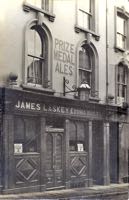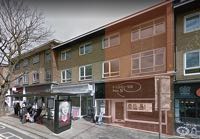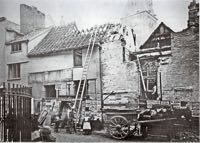
Exonia Vaults–South Street
Previously the College Kitchen and the Bear Inn
Page added 23rd February 2018
 Exonia Vaults in South Street, lost in the 1942 blitz, could trace its lineage as a hostelry back to 1767 and beyond, as the College Kitchen. It is thought that the actual building was contemporary with the 14th Century chauntry(1), of the College Hall of the Vicars Choral. Situated adjacent to the Hall, the early clientele would have been the clergy. The premises had a large, open, fireplace (exposed when it was demolished) for the roasting of meat. After the Reformation, the premises became a hostelry for the locals, especially those working in the wool market in South Street. The sign for the hostelry was a jolly monk holding a pipe and a foaming mug of ale.
Exonia Vaults in South Street, lost in the 1942 blitz, could trace its lineage as a hostelry back to 1767 and beyond, as the College Kitchen. It is thought that the actual building was contemporary with the 14th Century chauntry(1), of the College Hall of the Vicars Choral. Situated adjacent to the Hall, the early clientele would have been the clergy. The premises had a large, open, fireplace (exposed when it was demolished) for the roasting of meat. After the Reformation, the premises became a hostelry for the locals, especially those working in the wool market in South Street. The sign for the hostelry was a jolly monk holding a pipe and a foaming mug of ale.
A For Let notice in 1767 stated “…near Little Stile, now in Possession of George Hill, Victualler”. Cathedral Close was enclosed with a wall and seven gated entrances in 1286. Through the years, the wall was breached when doorways to properties were made–the College Kitchen had one such entrance, allowing patrons to enter the hostelry from South Street, pass through the premises and enter the Close via the door in the wall.
Skeleton in a box
In August 1828 an inquest was held at the College Kitchen into the murder of an infant at the hostelry–the body had been found in a locked, wooden box. Mrs Smith, the landlady told the Coroner that a woman called Jane Hendicott, formerly of Goldsmith Street, and later, the Maltster’s Arms, had lodged for six weeks at the house, three years before. The landlady went on to state that when Hendicott first arrived, she was taken ill, and a young man named Pepperell arrived and assisted her up the stairs, carrying a box. When the woman vacated, she owed 30s in rent, leaving the box as security. Six months before the discovery, the box was moved to the cellar. Recently, Mr Smith when in the cellar, noticed an unpleasant smell opened it to find, beneath some baby clothes, and remains of a baby.
William Pepperell was called to speak, and he said he had known Hendicott for five years. He had made the box for her, but was never paid. He didn’t know what the box contained.
Jane Hendicott, an inmate of the workhouse, and mother of an illegitimate child, when questioned, denied any knowledge of the dead baby, saying the box contained some linen and shaving equipment.
The jury inspected the contents of the box, and reported that they thought the remains were placed in it straight after birth. The Coroner concluded “… that the skeleton of the child was found in a box belonging to Jane Hendicott, nearly decomposed; but how it came by its death, or by whom deposited did not appear by the evidence adduced.”
The Bear Inn
Stephen Compton took over the place in 1840, and changed the name to the Bear Inn. The former Bear Inn, further down South Street had closed and became the headquarters for Russell’s the carriers, so there was little chance of any confusion. Compton was prosecuted in 1849 for harbouring a policeman. A policeman was seen by a colleague, entering the premises late at night when the place was closed. Compton was in bed, ill, so his wife dealt with the matter. Harbouring a policeman meant that he had offered a drink to a policeman while he was on duty. The case was dismissed.
Compton died, aged 56 in 1851, and his wife Sarah took on running the house. She left after 22 years and the house was let and licensed by George Leach. In July 1860, James Sampson formerly of the Turks Head took over the inn. He was an experienced landlord, well known in the city. Sampson died in March 1865–the business was continued by his wife, Maria until 1867 when William Gibbs took over the house.
Demolished and rebuilt–Exonia Vaults
South Street in the 1870s was in a constant state of demolition for road widening, and rebuilding. It was the turn of the Bear Inn, when it was taken down in 1871. Local historians noted the age of the walls, especially at the rear, and that they appeared to date from when the Vicars Hall was constructed in the 14th Century.
There is nothing about the place in the newspapers for several years, but it is known it was renamed Exonia Vaults. It was listed in 1878, with James Dunsford as the victualler. In 1886 Mrs Dunsford’s hosted a substantial supper for competitors of a shooting match between married and single men of the 1st D.A.V. (5th and 6th Batteries).
In September 1889, Mrs Dunsford married Mr William Hexter of the Star stores–now the Mint– and left the Bear Inn.
Several landlords passed through until 1916, when it was threatened with closure because of rowdy behaviour, but remained open on appeal to the magistrates. It was again threatened with closure in 1923, leading to this witty exchange with the chair of the magistrates:
"Messrs Starkey, Knight and Ford of Tiverton are the owners of the Exonia Vaults, South Street, formerly known as the Bear Inn, and one of the oldest in Exeter.
The police stated that it was a good house, well conducted by Mr Laskey the landlord. Within a radius of three hundred yards there were 32 fully-licenced houses, but the licencee said the house was frequented by working classes, and in six months his takings were £1,203 gross. Some “toffs” however went there.
Chairman: “What are “toffs”?
“Well a bit swanky, sir. There is one on the Bench” (Laughter)
Edward Crease, manager for the owners, said his firm originally had seven houses in Exeter, but three had been taken away. The Exonia was, perhaps, their best house, and they took pride in it.
Lee Wright, surveyor, said the house ought not to be closed. It was in good order, well constructed, and had a good tenant.
Subsequently Mr McGahey remarked: “I don’t know what weigh with magistrates.”
The Chairman: “I don’t think that anybody does.” (Laughter)
The licence was renewed."
James Laskey continued running the place until 1939, and probably until the building was lost in the May 1943 blitz.
Sources: British Newspaper Archive, trade directories including Besley and Kellys.
(1) A chapel for the saying of mass, and prayers for the souls of the mostly rich.
│ Top of Page │



